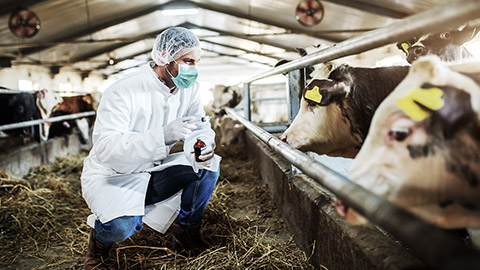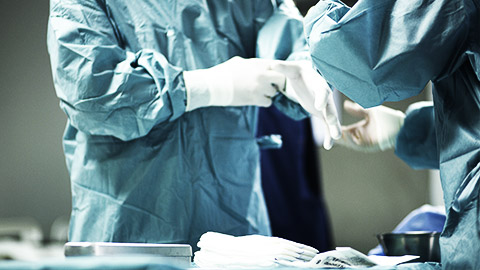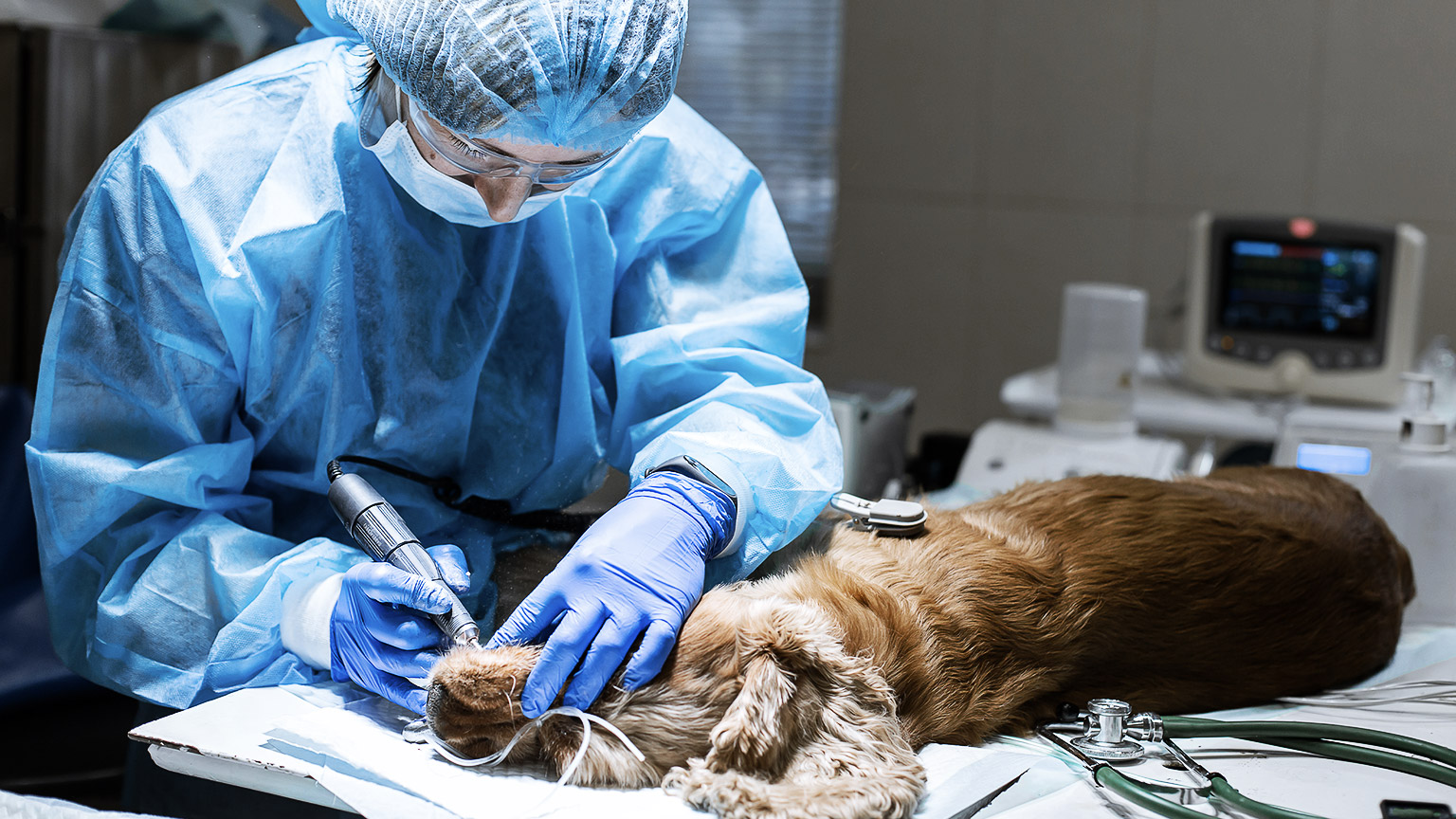Animals get ill from time to time and caring for them involves following specific routines in addition to normal hygiene duties so that infection or infestation do not spread. In certain animal care environments caring for ill animals will be a daily occurrence due to the basic purpose of the facility, ie. a veterinary clinic. In other types of animal care situations, an illness may occur due to the close confines of the animals and the high level of turnover with new incoming residents arriving daily, potentially with new germs or diseases.
There are three major components of disease transmission:
-
Source of infection
Greater community transmission is spread due to one host person/animal secreting an infectious agent (ie. body fluid) and contaminating others. These animals may not display any symptoms themselves (asymptomatic). Animals may also be convalescent - which means they have had the disease and stopped displaying symptoms but did not or have not fully recovered and could still be contagious.
-
Susceptible host
Certain animals are more prone to infection than others. These include immunocompromised patients, injured animals, the elderly and/or the very young.
-
Means of transmission
Germs can't travel on their own, they rely on a means of transmission to move from one host to another. This may be through physical contact, aerosol (inhaled droplets), fomite (germs left on objects), oral and vector (biting). Transmission can also occur between mother and infant during pregnancy, the birthing process or less commonly via milk.
Preventing spread relies on removing one or all of these links. Means of transmission is the easiest to prevent/control through practices such as hand washing, cleaning / sanitising, and the use of personal protective equipment. All animals should be considered a potential source of infection and a certain level of personal hygiene and cleanliness must be observed even when caring for healthy animals, these practices become more stringent if a contagious illness is identified.
You need to be prepared that some of the animals in your care may be presented very ill. They will need to be regularly monitored and their condition regularly updated on their records to observe any changes in their condition. If there are significant changes noted, their care will need to be adjusted, this includes either an increase in medication or fluids. These changes are only to be implemented by the veterinarian, while you can report them, you need to ensure the vet is the person who is making and implementing any of these significant changes.

When dealing with infectious animals, you need to ensure you follow the infection control guidelines. They are listed as follows.
- Hands should be washed before and after handling animals.
- Wear appropriate PPE whenever touching/handling broken skin, discharges, blood, mucous membranes, body fluids/excretions.
- Regularly clean and sanitise surfaces such as cages, pens and enclosures; door/cupboard handles; counters/benches; utensils; computer equipment; phones; EFTPOS machines.
- Dispose of waste regularly as per your workplace procedures.
Your workplace may have certain paperwork or records that need to be completed regularly to maintain infection control. This may include:
- Date and time of last cleaning activity.
- Medication administration records.
- Health examination notes.
- Vaccination history.
- Food and water intake charts.
You must always complete these records accurately as other staff rely on them.

Some animals will have illnesses that require them to be quarantined. Quarantine is a period of isolation where an animal (or human) has come into contact with a highly infectious disease. None of us should be any stranger to isolation or quarantine in the wake of the COVID-19 pandemic; conceptually, quarantining for animals is much the same.
When an animal has been diagnosed with a contagious disease, the animals will need to be kept away from the general population to avoid transmission of disease. These animals will need to be located in an isolation ward (ISO-W).
Many animal hospitals and some holding facilities will have a designated isolation ward or area where animals will need to be housed and treated until they are no longer infectious or pose a risk to other animals in the general population. The ISO-W will need to be separate from the rest of the facility with only designated personnel to enter and exit the ward. Isolation wards should always be low traffic; meaning as minimal people passing through as possible and ensure there are separate entry and exit points that do not cross over with the general population. This is particularly important when the animal has been diagnosed with a contagious disease during their consultation and requires immediate isolation.
Several points need to be considered when working in an isolation ward. Take some time to read through the following considerations for the isolation ward.
- Separate ventilation where possible to avoid airborne contagions from travelling through the air vents with the inclusion of extraction fans to direct the airflow outdoors rather than to other parts of the facility.
- It would be ideal for appropriately trained staff work in the ISO-W where they have been trained according to the standard operating procedures.
- Ensure the standard operating procedures are kept accessible to designated staff at all times.
- The isolation ward should have clear signs to identify the area and should also stipulate the use of PPE and the relevant biosecurity protocol.
- There should be a login book at the entry and exit points of the ISO-W to account for all staff who are entering and leaving the ward.
- No other personnel aside from the allocated staff and owners of the hospitalised animal should admit to the isolation ward.
Hygiene in isolation
Hygiene is always an integral aspect of your job in the animal care industry. This is emphasised even further when working in an isolation ward. Certain measures need to be considered to avoid any possible chance of transmission to other parts of the hospital and minimise the risk of taking it home with you.
The PPE you would likely require in the isolation ward will include, protective clothing (preferably disposable), double gloves (wearing an inner and outer pair of nitrile gloves), face masks, face shields and foot coverings. Any gowns that are in use, are to be worn once and either disposed of or carefully laundered.
At the entry and exit points of the ISO-W, you will often find a foot mat or footbath. These footbaths or foot mats are usually soaked with disinfectant. Which the relevant staff will need to step into and wash their shoes to avoid transmitting bacteria from the floor. The footbaths and foot mats should be regularly cleaned to avoid bacterial build-up. It is also important to exercise caution when walking because the soles of the feet will be wet.
Once the patient has been cleared to leave the ISO-W, the area where the animal was held will need to be cleaned twice to ensure all bacteria has been cleaned. The bedding and waste must be treated as infectious and disposed of as per SOPs- this may involve incineration.
Any personnel who launder bedding, gowns or other items from the isolation ward must follow the hygiene protocols relevant, including that of hand hygiene and wearing appropriate PPE. Laundry items should be washed separately from other hospital laundry and washed at a minimum of 40 degrees. For disinfection, the washing cycle should include detergent and bleach. Laundry should be dried in a hot air drier to ensure all bacteria has been exterminated.2
Patient management
When managing patients in the isolation ward, avoid moving them out of this area unless they are being discharged or being taken for tests such as radiology. If the animal can and requires small amounts of exercise, such as dogs needing to be walked, they must only carry out the exercise in an allocated part of the isolation ward and away from other animals. When taking specimen samples for testing (such as faeces or blood), they need to be collected in leak-proof containers clearly labelled with animal’s details. The specimen should be placed in a labelled specimen bag (should be double-bagged) and disinfected before leaving the ISO-W en route to the laboratory.
Environmental management
When the animal in isolation needs to urinate or defecate, they will need to be taken out via the least traffic-heavy route possible and should not be taken out through the general ward where they may come across other animals and potentially infect them.
The area in which the animal is taken must be kept separate from other patients, including other animals in the isolation ward. The area should be made of non-porous materials such as cement rather than grass to avoid the contaminated waste from absorbing and posing transmission to others. Animal waste such as faeces needs to be disposed of with other contaminated waste from the ward and any area which the animal has crossed through to, including routes from their housing to the outdoor area must be thoroughly disinfected once the animal has returned to their housing.

Bacteria, viruses, and other microorganisms that cause disease are called pathogens. Pathogens often enter the body when there is a cut or wound in the skin, however, they can also enter through other openings. To protect animals from harmful bacteria and other pathogens during medical procedures, animal care providers use the aseptic technique.
There are four aspects of the aseptic technique:
Barriers
Sterile barriers such as gloves, gowns, masks, and drapes help to prevent pathogens from being transferred to the animal from the animal care worker, the environment, or a combination of both. Sterile barriers are specially packaged and/or clean items that have not touched a contaminated surface. There are specific processes in place for using/wearing these items to minimise exposure to germs.
Animal (patient) and equipment preparation
The animal's fur/hair and skin are another potential source of contamination during a medical procedure, therefore animal care workers will shave/clip unnecessary fur and hair and apply a topical cleansing and bacteria-killing solution to the skin before making any incisions.
Environmental controls
This refers to the simple process of isolating the treatment area with closed doors and windows and limiting the number of people who are present. Unnecessary bystanders increase the risk of contamination.
Contact guidelines
Once animal care workers are wearing their sterile barrier equipment, they must be extremely careful to not touch any non-sterile items including their bodies.
All animals that are ill or injured need to be monitored regularly. Special consideration must be made for any patients that are immunocompromised, severely injured, elderly or very young/orphaned.
The process of monitoring indicators of recovery can be achieved by using a clinical score sheet. These documents have a series of parameters that an animal carer can check at each patient observation (usually twice a day).
Each parameter has a series of condition descriptions with an allocated score. Based on observation and basic tests (such as vital signs) an overall score can be ascertained for the animal which then falls within a series of judgements ranging from 'Normal' to 'Severe distress, consider euthanasia'. Based on these judgements decisions can be made regarding ongoing care.
An example of a clinical score sheet has been constructed below:
| Parameter | Condition Description | Score |
|---|---|---|
| Appearance | Normal | 0 |
| General lack of grooming | 1 | |
| Coat staring, ocular and nasal discharge | 2 | |
| Piloerection, hunched up | 3 | |
| Food and water intake | Normal | 0 |
| Uncertain: bodyweight decrease of <5% | 1 | |
| Intake: bodyweight decrease of 10-15% | 2 | |
| No food or water intake | 3 | |
| Clinical signs | Normal temperature, cardiac and respiratory rates | 0 |
| Slight changes in the above | 1 | |
| T± 10°C, a C/R rate change of 30% | 2 | |
| T± 20°C, a C/R rate change of 30% or large decrease | 3 | |
| Natural behaviour | Normal | 0 |
| Minor changes | 1 | |
| Less mobile and alert, isolated from companions | 2 | |
| Vocalisation, self-mutilation, restless or still | 3 | |
| Provoked behaviour | Normal | 0 |
| Minor depression or exaggerated response | 1 | |
| A moderate change in expected behaviour | 2 | |
| Reacts violently, or very weak and pre-comatose | 3 | |
| Score | If you have scored a '3' more than once, score an extra point for each '3'. | 2-5 |
| Judgement | 0-4 = Normal | |
| 5-9 = Monitor carefully, consider analgesics/other treatments. | ||
| 10-14= Suffering, provide relief, observe regularly. | ||
| 15-20 = Sever distress, consider euthanasia |
